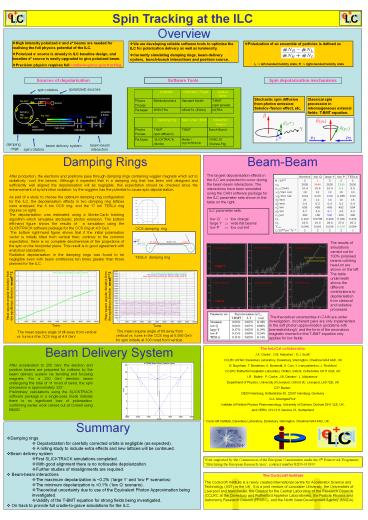Software Tools - PowerPoint PPT Presentation
1 / 2
Title:
Software Tools
Description:
As part of a study to choose the optimum damping ring configuration for the ILC, ... Merlin / SLICKTRACK. SLICKTRACK, (Merlin) Spin Tracking at the ILC ... – PowerPoint PPT presentation
Number of Views:17
Avg rating:3.0/5.0
Title: Software Tools
1
Overview
- High intensity polarized e- and e beams are
needed for realising the full physics potential
of the ILC. - Polarized e- source is already in ILC baseline
design, and baseline e source is easily upgraded
to give polarized beam. - Precision physics requires full cradle-to-grave
spin tracking.
- We are developing reliable software tools to
optimise the ILC for polarisation delivery as
well as luminosity. - Currently simulating damping rings, beam delivery
system, bunch-bunch interactions and positron
source.
- Polarization of an ensemble of particles is
defined as - L ? left-handed helicity state, R ?
right-handed helicity state
Software Tools
Spin depolarisation mechanisms
Undulator Collimator / Target Capture Optics
Physics Process Electrodynamics Standard Model T-BMT (spin spread)
Packages SPECTRA GEANT4, (EGS4) ASTRA
Classical spin precession in inhomogeneous
external fields T-BMT equation.
Stochastic spin diffusion from photon emission
Sokolov-Ternov effect, etc.
Damping ring Main Linac / BDS Interaction Region
Physics Process T-BMT (spin diffusion) T-BMT Bunch-Bunch
Packages SLICKTRACK, (Merlin) Merlin / SLICKTRACK CAIN2.35 (Guinea-Pig)
Beam-Beam
The largest depolarisation effects in the ILC are
expected to occur during the beam-beam
interactions. The interactions have been
simulated using the CAIN software package for the
ILC parameter sets shown in the table on the
right.
ILC parameter sets low Q ? low
charge large Y ? wide flat beams low
P ? low current
The results of simulations carried out for 100
polarised beams colliding head-on are shown on
the left. The table underneath shows the
different contributions to depolarisation from
classical and radiative processes.
The theoretical uncertainties in CAIN are under
investigation. Incoherent pairs are only
implemented in the soft photon approximation
(problems with bremsstrahlung!), and the form of
the anomalous magnetic moment in the T-BMT
equation only applies for low fields.
Beam Delivery System
After acceleration to 250 GeV, the electron and
positron beams are prepared for collision by the
beam delivery system via bending and focusing
magnets. For a 250 GeV electron beam undergoing
the total of 11 mrad of bend, the spin precession
is approximately 332. Preliminary calculations
using the SLICKTRACK software package in a
single-pass mode indicate there is no significant
loss of polarization, confirming earlier work
carried out at Cornell using BMAD.
Work supported by the Commission of the European
Communities under the 6th Framework Programme
Structuring the European Research Area,
contract number RIDS-011899.
2
Work supported by the Commission of the European
Communities under the 6th Framework Programme
Structuring the European Research Area,
contract number RIDS-011899.
Beam Delivery System
e-
e
11 mrad NLC-style Big Bends
2 mrad (L 4.5 m) dump lines
2 mrad ILC FF (x 2)
IR2 2 mrad
20 mrad ILC FF9 (x 2)
IR1 20 mrad
IP separation 138.4 m (Z), 20.4 m (X)
Path length difference (to IR2) 3 400 1.3 GHz
periods 276.7315 m
20 mrad (L 6 m) dump lines
Fig.5 Layout of BDS ( Copy from BDS ILC_at_
SLAC presentation)
After acceleration to 250 GeV, the electron and
positron beams are prepared for collision by the
beam delivery system. Initial studies show that
the depolarisation due to synchrotron radiation
in the total of 11 mrad of horizontal bends is
negligible, but further careful evaluation is
still needed.
Plans
- We will maintain the rolling study for DR to
include extra effects as necessary. - It is clear that the effects of misalignments
for BDS will require careful further study.































